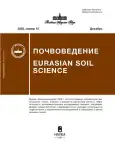Eurasian Soil Science
ISSN (print): 0032-180X
Founder: Russian Academy of Sciences
Editor-in-Chief: Krasilnikov Pavel Vladimirovich, corresponding member RAS, Doctor Sc., Associate Professor
Frequency / Assess: 12 issues per year / Subscription
Included in: White List (1st level), Higher Attestation Commission List, RISC
Media registration certificate: ПИ № ФС 77 – 71359 от 17.10.2017
Current Issue
No 12 (2025)
SOILS OF THE POLAR REGIONS
Influence of Thermodenudation on the Formation of Synlithogenous Soils and Ecosystem Development in the Permafrost Zone
Abstract
 1637–1653
1637–1653


PROTO-SOILS OF THE POLAR REGIONS: A STUDY OF ORGANIC AND MINERAL COMPONENTS WITH THE USE OF RAMAN SPECTROSCOPY
Abstract
 1654-1668
1654-1668


Radiocarbon Dating of Polar Soils: Application Features and Genetic Interpretations of Results (Review)
Abstract
 1669–1691
1669–1691


Biological Activity of Soils and Soil-Like Bodies of the Western Part of the Arctic Zone of the Russian Federation
Abstract
 1692–1706
1692–1706


Stocks of "Blue Carbon" in Soils of Coastal Ecosystems of High-Latitude Seas of the Northern Hemisphere
Abstract
 1707–1733
1707–1733


Spatial And Geochemical Characteristics of the Soils of the Barents Sea Sector of the Arctic Zone of the Russian Federation
Abstract
 1734-1751
1734-1751


Cryogenic Micropatterns of Soil Cover within the Typical Tundra Subzone of European Russia
Abstract
 1752–1768
1752–1768


Arctic and Tundra Micro-Associations on the Soil Map of Russia at a Scale of 1 : 2.5 million in the New Russian Soil Classification System
Abstract
 1769-1782
1769-1782


Probabilistic Regularities of Soil Cover Patterns in Landscapes with Polygonal Wedge Ice Development
Abstract
 1783-1795
1783-1795


Soils of Karst Sinkholes of the Polar Urals: Morphology, Genesis, Classification
Abstract
 1796-1815
1796-1815


Morphological Structure and Physicochemical Parameters of the Medvezhye Islands Archipelago Soils (North-Eastern Yakutia)
Abstract
 1816-1830
1816-1830


The Role of Cryogenic and Cryopedogenic Processes of the Past in the Formation of Al–Fe–Humus Soils in the Nadym–Pur Interfluve, Northern Western Siberia
Abstract
 1831-1846
1831-1846


Potentially Toxic Elements in Soils of Cities in the Oil and Gas Region of Northern Western Siberia (Novy Urengoy, Nadym, Noyabrsk)
Abstract
 1847-1862
1847-1862


Microstructure and Mineral Composition of Long-Cultivated Permafrost Affected Soils from the Yamal Experimental Agrostation (Salekhard, Yamal-Nenets Autonomous Okrug)
Abstract
 1863-1877
1863-1877


Postpyrogenic Changes in the Properties of Organic Matter in Cryosols of Western Siberia forest-tundra
Abstract
 1878-1890
1878-1890












